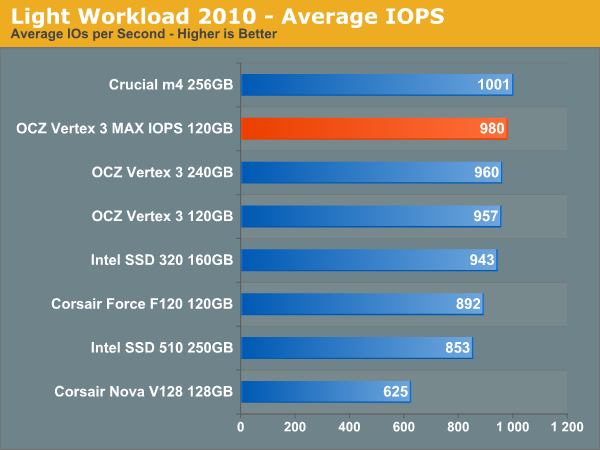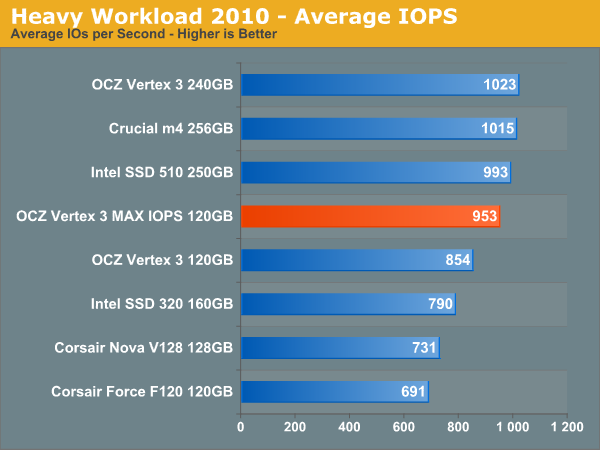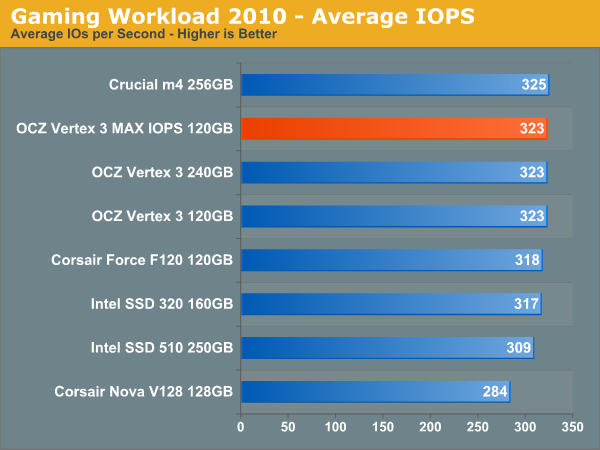OCZ Vertex 3 MAX IOPS & Patriot Wildfire SSDs Reviewed
by Anand Lal Shimpi on June 23, 2011 4:35 AM ESTAnandTech Storage Bench 2010
To keep things consistent we've also included our older Storage Bench. Note that the old storage test system doesn't have a SATA 6Gbps controller, so we only have one result for the 6Gbps drives.
The first in our benchmark suite is a light/typical usage case. The Windows 7 system is loaded with Firefox, Office 2007 and Adobe Reader among other applications. With Firefox we browse web pages like Facebook, AnandTech, Digg and other sites. Outlook is also running and we use it to check emails, create and send a message with a PDF attachment. Adobe Reader is used to view some PDFs. Excel 2007 is used to create a spreadsheet, graphs and save the document. The same goes for Word 2007. We open and step through a presentation in PowerPoint 2007 received as an email attachment before saving it to the desktop. Finally we watch a bit of a Firefly episode in Windows Media Player 11.
There’s some level of multitasking going on here but it’s not unreasonable by any means. Generally the application tasks proceed linearly, with the exception of things like web browsing which may happen in between one of the other tasks.
The recording is played back on all of our drives here today. Remember that we’re isolating disk performance, all we’re doing is playing back every single disk access that happened in that ~5 minute period of usage. The light workload is composed of 37,501 reads and 20,268 writes. Over 30% of the IOs are 4KB, 11% are 16KB, 22% are 32KB and approximately 13% are 64KB in size. Less than 30% of the operations are absolutely sequential in nature. Average queue depth is 6.09 IOs.
The performance results are reported in average I/O Operations per Second (IOPS):

If there’s a light usage case there’s bound to be a heavy one. In this test we have Microsoft Security Essentials running in the background with real time virus scanning enabled. We also perform a quick scan in the middle of the test. Firefox, Outlook, Excel, Word and Powerpoint are all used the same as they were in the light test. We add Photoshop CS4 to the mix, opening a bunch of 12MP images, editing them, then saving them as highly compressed JPGs for web publishing. Windows 7’s picture viewer is used to view a bunch of pictures on the hard drive. We use 7-zip to create and extract .7z archives. Downloading is also prominently featured in our heavy test; we download large files from the Internet during portions of the benchmark, as well as use uTorrent to grab a couple of torrents. Some of the applications in use are installed during the benchmark, Windows updates are also installed. Towards the end of the test we launch World of Warcraft, play for a few minutes, then delete the folder. This test also takes into account all of the disk accesses that happen while the OS is booting.
The benchmark is 22 minutes long and it consists of 128,895 read operations and 72,411 write operations. Roughly 44% of all IOs were sequential. Approximately 30% of all accesses were 4KB in size, 12% were 16KB in size, 14% were 32KB and 20% were 64KB. Average queue depth was 3.59.

The gaming workload is made up of 75,206 read operations and only 4,592 write operations. Only 20% of the accesses are 4KB in size, nearly 40% are 64KB and 20% are 32KB. A whopping 69% of the IOs are sequential, meaning this is predominantly a sequential read benchmark. The average queue depth is 7.76 IOs.











112 Comments
View All Comments
GullLars - Thursday, June 23, 2011 - link
I noticed the clear winner at your 4KB random read (QD3) test has been cleared from the chart. The C300 pushes over 90MB/s while the second highest, and the highest in this cart, is Vertex 3 240GB with 68MB/s. I feel this is worth noting, as the SF-2281 drives generally win with a good margin in many tests, but loose to a more than year old drive in small random reads at low queue depths.Bannon - Thursday, June 23, 2011 - link
Thanks for another good review Anand. I've been following the discussions in the Corsair and OCZ forums and while I'm interested in the super-fast speeds of the new SandForce drives I'm leery because of the problems a percentage of their customers are having. So, I was considering a 256GB Crucial M4 drive which seemed to do well in your review but was surprised when you recommended the Intel 510 drive as an alternative. Do you have concerns with the M4?ocz2004 - Thursday, June 23, 2011 - link
Hello everyone, as my first post in this thread let me identify myself as an OCZ employee. I’d like to thank everyone for their comments. Positive or negative, we appreciate all the feedback and take it very seriously throughout the organization. We continue to see a very small percentage of users with the BSOD issue but have made addressing this a high priority, and encourage any customers that have this or any issues to contact our customer service team. We have and will continue to work closely with SandForce and our platform partners for a final fix, and have spearheaded this effort among all manufacturers that utilize a SF solution. As mentioned in our previous public statement, we are also working on optimizations to the base code to minimize any performance delta associated with the temporary workaround. Thank everyone again for your support and feedback, and we will continue to work diligently on providing both premium performing and reliable SSDs to all our valued customers. We are willing to go above and beyond to make our customers happy; for anyone that is having this issue please contact support at drego @ ocz dot comtecsi - Thursday, June 23, 2011 - link
From Anand's comments:"It turns out that although the move from a hard drive to a decent SSD is tremendous, finding differences between individual SSDs is harder to quantify in a single real world metric...The best values in SSDs are going to be last year's models without a doubt."
It appears that the best desktop SSD value--by far--is grabbing a 64GB SATA II boot/app drive (paired with a big HD), which are often rebated to ~$70. Although SATA III and 120GB/240GB look great on a specialized SSD racetrack, in the real world the performance difference appears to be a 5-10%, while paying just 30% of the $250 cost for a SATA III 120GB drive.
Does this make sense or am I missing something? I was getting quite excited about SATA III and all the fawning over the Vertex 3, but this enthusiasm seems misplaced.
Impulses - Thursday, June 23, 2011 - link
Only issue with that is that after formatting and installing the OS, a 64GB SSD doesn't leave you a lot of extra space... Depending on your needs that may or may not be an issue. I got an 80GB Intel X25-M for my desktop last year and it's a little tight, I have the luxury of having enough space for a couple of games but I do rotate which ones I have on it... I'm looking at 120GB drives but I'm waiting for prices to come down a little.I got a 40GB X25-V for my netbook tho and it's just for that kinda system... Win7 and the basic kind of programs that I use on my netbook all fit fine within <25GB, and with only 1.5GB of RAM the size of the hibernate file isn't a big concern. Still got enough space for a couple of movies when I travel.
FunBunny2 - Thursday, June 23, 2011 - link
Over on Postgresql-performance, for one, there is not much love for anything less than full blown cap-backed SSDs, and even then, when used for database logs (not necessarily a good use of an SSD) 18 months is about the lifetime.So, using highly normalized (BCNF, which you shouldn't have to look up) X00 gig databases only on SSD (no HDD for logs and such) is a real torture test. Random access in a real world application. Oracle and MS have them. TPC, of course, has a bunch.
jdmstl - Thursday, June 23, 2011 - link
I had a problem with the Vertex 3 240GB in a new Thinkpad W520. The bluescreen occurred at relatively light or idle usage, but seemed to have nothing to do with power save features. I tried disabling all such features in the bios, as well as a number of logical software fixes to no avail.Finally, I simply returned the drive to Microcenter for a refund rather than deal with the issues. I never posted my problems to OCZ, although I read the related forum posts for clues.
I suspect that many people did the same, so I would not trust any defect rate figures based on number of forum posts. It would be more accurate to check the return rate, but I suspect that many people just ignore the BSODs and live with it without reporting any issue, assuming it will all work out eventually.
OCZ tries to deny or downplay issues without taking full responsibility. They did the same thing with JMicron controller problems a few years ago. (Not that any other brands were more honest or forthcoming.)
I think I will stick with Intel from now on, although I had good luck with 4 of the original Vertex Indilinx drives that are still running fine in my home desktop PCs.
jwilliams4200 - Friday, June 24, 2011 - link
OCZ is definitely the leader when it comes to their propaganda machine. It seems even Anand has gotten brainwashed by it.Concillian - Friday, June 24, 2011 - link
It really helps to read that page to put the performance picture in perspective. This kind of thing is difficult to get a feel for when looking at reviews.It's easy to tell which is faster from benchmarks, but it's not always easy to tell how much that speed will translate into actual perceivable improvement for daily workloads.
I think you should throw in a few "vs. rotating storage" charts in every SSD review just to help demonstrate the performance differences to those contemplating the jump to SSD. Many of your readers have made the jump and are looking at SSDs vs. SSDs, but I'll bet a fair amount are still looking at the value vs. a hard drive and haven't necessarily seen the history of all the articles that show these differences.
cactusdog - Friday, June 24, 2011 - link
I respect Anands opinions but the timing of his reviews and comments(regarding OCZ) makes it seem he is working with OCZ. Like he wont say anything negative unless OCZ have already addressed it.Its strange this review hit just after the new firmware 2.09 was released. The 2.09 firmware that is supposed to fix any BSOD issues.
Going back over previous reviews, Anand never mentioned any of the user complaints about slower 25nm nand (and the use of slower hynix or second rate Spectek nand) until AFTER OCZ had put out an official statement about it. Until OCZ had promised to swap drives and promised not to use dodgy nand again.
The point is Anand seems to have a direct line to OCZ and he will not address users concerns until AFTER OCZ has officially recognised it in some way.